Telltales: how they work, how to use them to steer a close-hauled course and how to interpret their behaviour
However many boxes of clever electronics we load our boats down with to tell us where to go, how far away it is and how long it will take to get there, it’s a fact that no one has yet invented the instrument that will tell you how your sails are being trimmed.
Nothing is as accurate as a short length of wool to let you know how to trim your sails or how to steer to them. Telltales are the aforementioned lengths of wool, stuck to the sail, which show the airflow over the sail. But how do they work?
When the luff of your sail passes through the wind, the velocity of the wind decreases at the sail’s surface due to the friction it encounters. This is known as the ‘boundary layer’. If the sail is trimmed correctly, the boundary layer stays intact, the telltales stream aft comfortably and it’s performing as well as it can.
However, once the velocity of the boundary layer decreases too much, it separates from the sail, which results in even more of a decrease in speed and generated power – not what we’re looking for when trimming a sail.
If you are too close to the wind, or the sail is under-trimmed, the boundary layer slows and separates on the windward side of the sail, creating an eddy on that side of the sail which starts the telltale lifting. If you are too low or the sail is over-trimmed, the opposite happens – the boundary layer on the lee side of the sail slows, separates, causes an eddy and you lose a lot of power. The telltales will alert you to what’s going on by deviating from their normal, happy streaming.
That’s the theory, anyway, but what does it look like in practice out on the water – and what can you do to remedy the situation? Here’s how to read the sails.
Using telltales to trim the jib
One major use of telltales is to check and set sail trim. For a jib, that means the car position. With the car too far aft, the top of the sail twists off, but with it too far forward the leech closes, which can overpress the boat and slow you down. This is why most jibs have two or three sets of telltales on them. To see what happens, head up slowly until the telltales just start to lift, and see what the telltales tell you.
▼ Problem: The top set of telltales lift first
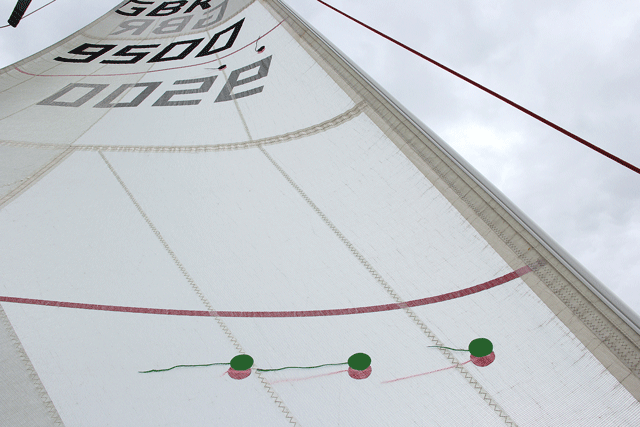
What this means: The jib is twisted off, which usually means that the jib car is too far aft. This is no bad thing when it’s windy as the extra twist helps to depower the sail, but in lighter winds it’s a good idea to give the top of the sail less twist and thus more power. Move the jib car forward, which will alter the pull of the jib sheet to pull down the leech more and close off the top.
▼ Problem: The lower set of telltales lift first

What this means: The top of the jib is closed off and over-sheeted, while the lower part is under-sheeted – most likely, the jib car is too far forward. This is especially bad when it’s windy and you could do with some more twist in the sail to depower the top. Move the jib car aft to open the top and close the bottom part of the sail.
Using telltales to steer a close-hauled course
With your jib trimmed in correctly, the telltales show you how to steer upwind. Sailing as high as possible will get you to your destination faster, so it’s worth staying on the breeze as long as you can.
▼ Problem: All windward telltales lifting

What this means: You’re sailing too high and close to the wind, which is slow. Bear away until all the telltales are streaming smoothly aft.
▼ Problem: All leeward telltales drooping

What this means: You are sailing too low, reaching off. Head up until the windward telltales start to lift, then bear away to keep them streaming aft – staying in the interface between streaming aft and just beginning to lift will ensure you’re on the wind all the time.
- Telltale tips – beating in waves
For power, keep the leeward telltale on the jib stalling slightly to keep the boat moving in the waves. - Pointing or ‘squeezing’ – keep the windward telltale luffing every now and then so that it squeezes you up above an obstruction. You don’t want it to be stalling all the time, but flicking back and forth between straight and 45°.
- Don’t sail rigidly to keep them all streaming. Do feather a little, and don’t fight the helm to keep the boat on course – it’s hard work!
Sailing on a reach
When you’re sailing on a reach, you can use your telltales to steer a course to match the jib trim, or to trim the jib to a fixed compass course. To steer to the jib, ease it the required amount and use the telltales as you would upwind to sail at the optimum angle for how the jib is trimmed. Far more likely is that you’ll be steering to a compass or fixed course: in which case, read on to find out how to trim the jib to your heading.
Trimming the jib to your reaching heading
If you’re sailing to a waypoint or steering on a compass heading, get the boat on course and settle down, then you can trim the jib as follows.
▼ Problem: Windward telltales are lifting or drooping
What this means: The jib is under-sheeted.
Pull in the sheet until all the telltales are streaming aft.
▼ Problem: Leeward telltales drooping

What this means: The jib is too tight for your current heading. Ease it until ease both sets of telltales are streaming aft.
Problem: Top twisted off, upper telltales lifting first
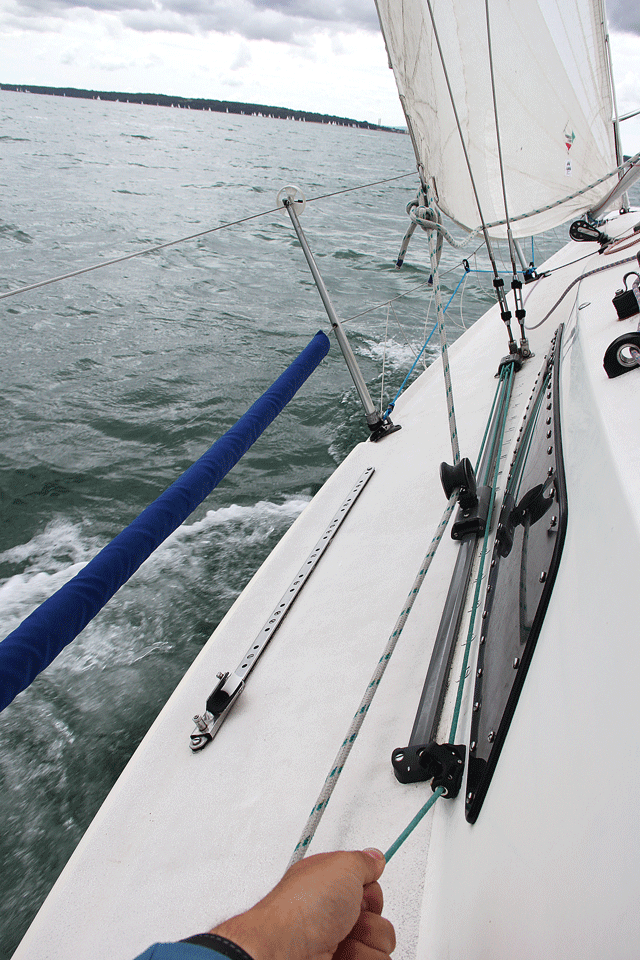
What this means: On a reach, you may find that the jib car position that was ideal for upwind sailing is wrong now you’re on a reach. This is because you had the sheet in tight upwind, but with the sheet eased it is no longer pulling down on the leech. The solution is to rig a reaching sheet, which can be a snatch block clipped to the toerail. This moves the sheet outboard and forward, pulling down on the leech and thus removing some of the twist. Moving the sheet
to the toerail moves the whole leech of the jib outboard and away from the mainsail – which is much faster on a reach. If nothing else, you can try moving the normal jib car forward, which will be better than nothing.
Placing telltales

On a jib, the best set-up is to have three sets evenly spaced along the luff so that you can see how the wind is flowing at different heights of the sail. Telltales should be 6-18in aft of the luff, depending on the size of the boat – the bigger the sail, the further aft the telltales should be. If they are too far forward they become confused by the flow from the headfoil and become too sensitive.
On a mainsail, there should be a telltale on the leech at each batten.
High-tech telltales
If you want to be able to read your telltales in all weathers and times of the day or night, there are some hi-tech options available.
Luminous pads

Glowfast glow-in-the-dark telltale pads let you see what’s happening at night, so you can keep the sails trimmed or keep heading close-hauled in the hours of darkness, by sticking a luminous pad behind the telltales so you can see their silhouette. The company has experimented with luminous telltales, but says their small size makes them almost invisible.
www.glowfast.com
LED telltales
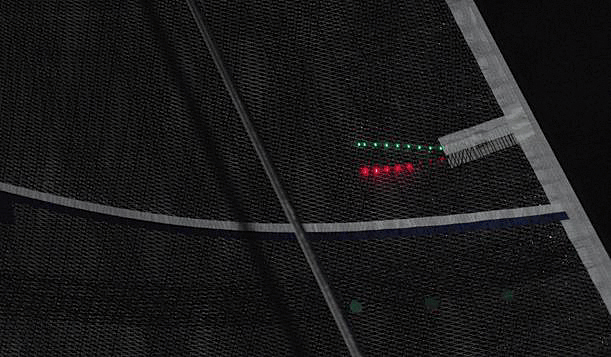
Tale-lites use a hi-tech circuit sewn into fabric to create a light-emitting textile, so your telltales light up at night. They are powered by a small battery plugged into the tack of the sail, and should be available from your sailmaker later this year.
www.tale-lites.com

Teflon telltales
British dinghy sailing equipment company Rooster Sailing has started selling telltales coated with a water-repelling Teflon substance to stop them sticking to the sail when they get wet – one of the major problems with woollen telltales.
www.roostersailing.com
Mainsail trim
Mainsails can also be trimmed with the help of telltales – but these tend to be ribbons of spinnaker nylon attached to the leech at each batten. These show the flow as it comes off the back of the mainsail. The mainsail is the main driver to help you point upwind, and it’s the air exiting the leech of the sail that determines how close to the wind you can sail, as well as how fast.
What the telltales say: all streaming aft

What this means: Unlike jib telltales, where you want them all to stream consistently, on the mainsail this suggests that the leech is too open – fine for reaching, but you’ll struggle to make much ground to windward. Try sheeting the sail in, with the traveller in the middle of the boat, until the top telltale starts to disappear round the back of the leech for around 40% of the time.
What the telltales say: top telltale visible 60% of the time, the rest visible all the time
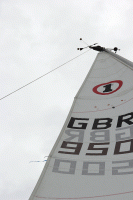
What this means: Perfect upwind mainsail trim; with the traveller pulled up so that the boom is
in the centreline and the sheet adjusted so that the top telltale flicks round the back. In light boats, you may need to play the traveller or mainsheet to keep the boat on her feet in the gusts.
What the telltales say: all disappeared
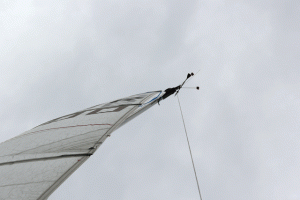 What this means: If all the leech telltales have disappeared, it indicates that the sheet is too tight, the leech is hooked and the airflow is struggling to escape the sail – and this means you’ll go slowly. Try easing the mainsheet until the telltales begin to appear one by one, then sheet on until the top one is flicking back behind the sail every now and then, and you should notice the boat’s speed beginning to build again.
What this means: If all the leech telltales have disappeared, it indicates that the sheet is too tight, the leech is hooked and the airflow is struggling to escape the sail – and this means you’ll go slowly. Try easing the mainsheet until the telltales begin to appear one by one, then sheet on until the top one is flicking back behind the sail every now and then, and you should notice the boat’s speed beginning to build again.
Trimming the mainsail on a reach
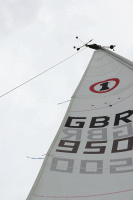
When trimming the mainsail on a reach, you don’t need the lift provided by the exit of the airflow from the mainsail to provide an upwind vector, so you don’t need the traveller in the centre. Instead, drop the traveller down and ease the sail until all the leech telltales are just appearing all the time. Ideally, the telltales will all be streaming, but on the verge of flicking behind the sail.
Beating in light airs
When beating in light airs, it helps to induce some twist into the sail. You can do this by pulling the traveller above the centreline and easing the sheet so that the top telltale is visible 60% of
the time, the rest are visible all the time and the boom is on the centreline – this will help the top twist off and keep everything breathing and moving well.





